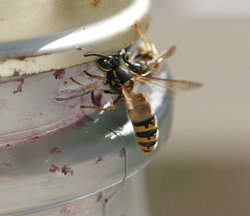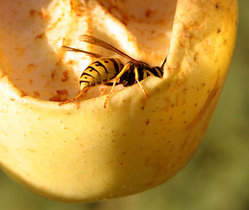Yellowjackets are black-and-yellow wasps of the genus Vespula or Dolichovespula (though some can be black-and-white, the most notable of these being the bald-faced hornet, Dolichovespula maculata). They can be identified by their distinctive combination of black-and-yellow color, small size (slightly larger than a bee), and entirely black antennae.
Like some other vespids, they live in colonies and build globular paper nests. Workers are around 12-20 mm in length, depending on species, and feed on nectar, while collecting other foods (primarily arthropods) for their larvae. They can sting repeatedly and without apparent provocation (especially so in response to nest disturbance), and so can be major pests. In autumn, they switch from collecting arthropods and nectar to scavenging other food sources, which can increase their contact with people.
Dolichovespula species' nests tend to be exposed, whereas Vespula species build concealed nests, usually underground.
European Yellowjackets (the German Wasp, Vespula germanica, or Common Wasp, Vespula vulgaris) were originally native to Europe, but are now established in North America, southern Africa, New Zealand, and eastern Australia.
Yellowjacket nests usually last for only one season, dying off in winter. The nest is started by a single queen, and typically can reach the size of a basketball by the end of the season. In parts of Australia and New Zealand, as well as certain southern and western coastal areas of the United States, the winters are mild enough to allow some nests to survive, which can then grow to 3-4 meters across.
The bald-faced hornet, Dolichovespula maculata, belongs among the yellowjackets rather than the true hornets, but is not usually considered one because of its ivory-on-black coloration.
Read more at Wikipedia.org



